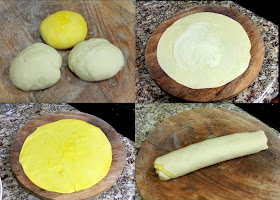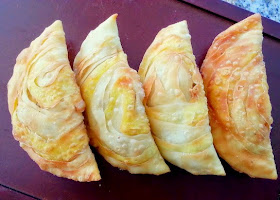Diwali is just around the corner. And Fall has finally arrived in San Diego. What a glorious time it is to be frying lots of things and using ghee abundantly. Despite the hot afternoons, dense morning fog and crisp evening air convinces me of the changing season and the approaching festive times. I started my Diwali preps over the weekend on a sweet note with flaky, melt in the mouth pastry called Khajachi Karanji or Satyachi Karanji.
Karanji is a fried pastry, much like empanadas, made with all purpose flour cover and some sort of sweet stuffing. Our traditional recipe has grated fresh coconut filling. My husband's side of the family makes a more fancy version of it. The cover is made by layering multiple rolled dough rotis with ghee in between. When fried, the layers separate, must like puff pastry, creating wonderfully flaky and crispy karanji. It's called Khajachi karanji for the layers resembling another sweet called Khaja. It also gets its other name, Satyachi Karanji or Karanji made with Sate, from the ghee-corn starch spread used to create layers. The spread is called Sate. This Karanji is stuffed with a fine dried coconut filling which adds to the melt-in-the-mouth quality. Some make the karanji cover using very fine rava or semolina. It needs to be pounded and requires more work. I took the easier route.

Husband specially asked me to make Karanji 'their style' since I'm making everything else using my mom's recipes. I am always up for trying something new, especially when it involves a sweet ;). I called up my mother-in-law, and got detailed instructions from her. My skills were at test, and I decided to post the recipe when husband gave me two thumbs up!
The recipe is a little tricky. And the instructions are long. But the picture tutorial should help in understanding how it's made. This elaborate preparation is worth every delicious bite!
**This recipe makes ~12 karanjis.
Khajachi Karanji/Satyachi Karanji
Ingredients:
Dough
1 Cup all purpose flour
2 Teaspoons melted hot ghee - must be absolutely hot, not warm
Couple of pinches salt
Water as needed
1 pinch saffron and 1 Tablespoon milk Or food color of choice (optional)
A little milk to seal karanji
Sate
2 Tablespoons corn starch
~ 2 Tablespoons ghee (or as much needed to create a smooth paste)
Filling
1/2 Cup dry grated coconut. If you grate an entire coconut, scrape off the black part.
2/3 Cup sugar
2 Tablespoons almonds
1/2 Teaspoon cardamom powder
To prepare the dough:
To prepare sate:
To prepare the filling:


To make karanji:

This is one of the many sweets and snacks I plan to prepare this year. Let me know what you're making for Diwali!
Submitting this recipe to the Dish it Out - Diwali Bash event @ Cook's Joy.

Husband specially asked me to make Karanji 'their style' since I'm making everything else using my mom's recipes. I am always up for trying something new, especially when it involves a sweet ;). I called up my mother-in-law, and got detailed instructions from her. My skills were at test, and I decided to post the recipe when husband gave me two thumbs up!
The recipe is a little tricky. And the instructions are long. But the picture tutorial should help in understanding how it's made. This elaborate preparation is worth every delicious bite!
Khajachi Karanji/Satyachi Karanji
Ingredients:
Dough
1 Cup all purpose flour
2 Teaspoons melted hot ghee - must be absolutely hot, not warm
Couple of pinches salt
Water as needed
1 pinch saffron and 1 Tablespoon milk Or food color of choice (optional)
A little milk to seal karanji
Sate
2 Tablespoons corn starch
~ 2 Tablespoons ghee (or as much needed to create a smooth paste)
Filling
1/2 Cup dry grated coconut. If you grate an entire coconut, scrape off the black part.
2/3 Cup sugar
2 Tablespoons almonds
1/2 Teaspoon cardamom powder
To prepare the dough:
- Mix all purpose flour, salt, and hot ghee. The ghee helps make the dough light.
- Add just enough water to prepare a stiff dough. It is important not to make the dough soft.
- Cover the dough under a damp cloth and let it sit for a couple of hours.
- If you want to make a two-colored karanji, you can use food color. Separate 1/3 and 2/3 flour. Add one color to 1/3 of the flour, and either keep the rest white or add another color. No one in my house is a big fan of artificial food color. So I added saffron to 1/3 of the dough. I added saffron to warm milk and crushed it until the color oozed out. Then added this milk to the dough.
To prepare sate:
- Mix corn starch and enough ghee to make a smooth paste in a small plate/bowl. Whisk this by fingers until it's mixed well and looks creamy.
To prepare the filling:
- Roast coconut on low flame until toasty (~5 mins). If you have sliced coconut, roast it and then grind it to a coarse powder. You don't want pieces of coconut poking through the dough.
- Grind sugar and almonds to a powder.
- Mix coconut, almond, cardamom powder, and sugar. Adjust the amount of sugar to your liking. Remember that frying tones the flavors down. Make sure the aroma of cardamom powder is prominent. Mix the filling well by hand.


To make karanji:
- Knead the dough well before making karanji. Make three parts of the dough.
- Roll out each part into a roti. Keep the dough covered under damp cloth while working on each roti to ensure it doesn't dry out.
- Take one roti, spread the corn starch mixture or sata by hand to create a thick coat all around. Place the second roti on top of it. Apply more sata and layer the third roti. Press gently by hand.
- Now create a tight roll, like a Swiss roll. Pinch off the ends to close.
- Cut the roll in half at an angle (as shown in the pic above). Cut each piece in half again. Now cut all 4 pieces in thirds - a total of 12 pieces. Keep them covered under damp cloth.
- Press each of the dough pieces by hand to flatten out. You want to flatten it from the side that shows the layers. Since they are at an angle, the layers will seal when pressed.
- Gently roll the dough ball using corn starch or all purpose flour so it doesn't stick. Don't roll too hard or else the layers will separate before frying - this will break the karanji while frying, spilling out the filling into the oil. You want to roll the dough like a puri - not too thick not too thin. This cover is called a paari.
- Place a large spoonful of the filling at the center of the paari. You want a decent amount of filling since the karanji will puff up after frying. Apply a little milk all around the edge of the pari, fold it in half and seal of the edges to create a boat shaped karanji. Press the ends well so that karanji doesn't open while frying. Don't leave any air iside. You can cut the excess ends using a karanji cutter, or a knife.
- Heat oil in a kadhai. Drop a small piece of dough. If the oil bubbles rapidly and the dough floats to the top right away, the oil is ready for frying. Lower the heat to medium and fry each karanji until golden. Don't turn the karanji too many times else it'll break. The layers in the paari should separate while frying.
- Take out the karanjis on a paper towel to absorb excess oil. Let them cool completely before storing. You don't want any steam remaining, else the karanjis will turn soft.
- Store in an airtight container once cooled. They can be stored for up to 2 weeks.

This is one of the many sweets and snacks I plan to prepare this year. Let me know what you're making for Diwali!
Submitting this recipe to the Dish it Out - Diwali Bash event @ Cook's Joy.

.jpg)


